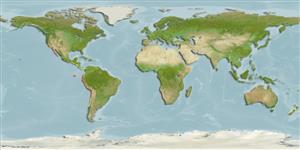>
Eupercaria/misc (Various families in series Eupercaria) >
Labridae (Wrasses) > Bodianinae
Etymology: Bodianus: Bodianus after Bodiano or Pudiano, from the Portuguese pudor, meaning modesty (Jordan & Evermann, 1896); eclancheri: Named for M. L’Eclancher (Ref. 75973).
Eponymy: Charles René Augustin Leclancher (1804–1857) was a French naval surgeon. [...] (Ref. 128868), visit book page.
More on author: Valenciennes.
Environment: milieu / climate zone / depth range / distribution range
Ecologia
marinhas associadas(os) a recifes; intervalo de profundidade 5 - 46 m (Ref. 5227). Tropical
Southeast Pacific: Ecuador to central Chile. Originating in the Peru-Chile Province, it is found in the cooler waters of the Galapagos Islands.
Tamanho / Peso / Idade
Maturity: Lm ? range ? - ? cm
Max length : 61.0 cm TL macho/indeterminado; (Ref. 5592); common length : 40.0 cm TL macho/indeterminado; (Ref. 55763)
Descrição suscinta
Chaves de identificação | Morfologia | Morfometria
Body moderately deep and compressed; head large and pointed; teeth elongate and compressed, resembling incisors; dorsal fin contiguous, with 12 spines; posterior rays of dorsal and anal fins forming filamentous lobes; lower branch of first gill arch with 9 to 10 gill rakers; variable, depending on size and sex; body brown, black, red or orange, but less than 5 percent of the population is entirely black (Ref. 55763).
A sequentially protogynous hermaphrodite. In the Galapagos, the colorful appearance may be due to selective pressures and their increased feeding and decreased reproductive activities may serve to avoid extraordinary predation (Ref. 9227). Adults forage on a wide range of invertebrates and algae (Ref. 28023). Oviparous, distinct pairing during breeding (Ref. 205).
Ciclo de vida ou comportamento de acasalamento
Maturidade | Reprodução | Desova | Ovos | Fecundidade | Larvas
Pelagic spawner (Ref. 32168). Oviparous, distinct pairing during breeding (Ref. 205). Also Ref. 103751.
Merlen, G., 1988. A field guide to the fishes of Galapagos. Wilmot Books, London, England 60 p. (Ref. 5590)
Status na Lista Vermelha da UICN (Ref. 130435: Version 2024-1)
Ameaça para os humanos
Harmless
Uso pelos humanos
Pescarias: sem interesse; Aquário: Espécies comerciais
Ferramentas
Relatórios especiais
Baixar XML
Fontes da internet
Estimates based on models
Preferred temperature (Ref.
123201): 16.6 - 24, mean 21.3 °C (based on 16 cells).
Índice de diversidade filogenética (Ref.
82804): PD
50 = 0.5000 [Uniqueness, from 0.5 = low to 2.0 = high].
Bayesian length-weight: a=0.01230 (0.00569 - 0.02662), b=3.05 (2.87 - 3.23), in cm total length, based on LWR estimates for this Genus-body shape (Ref.
93245).
Nível Trófico (Ref.
69278): 2.7 ±0.24 se; based on food items.
Resiliência (Ref.
120179): Baixo, tempo mínimo de duplicação da população 4,5 - 14 anos (Preliminary K or Fecundity.).
Fishing Vulnerability (Ref.
59153): Moderate vulnerability (44 of 100).
Nutrients (Ref.
124155): Calcium = 36.5 [20.2, 58.5] mg/100g; Iron = 0.533 [0.306, 0.983] mg/100g; Protein = 18.3 [15.4, 20.5] %; Omega3 = 0.114 [0.074, 0.177] g/100g; Selenium = 37.5 [21.7, 65.4] μg/100g; VitaminA = 71.6 [21.4, 255.8] μg/100g; Zinc = 1.41 [1.03, 2.30] mg/100g (wet weight);
